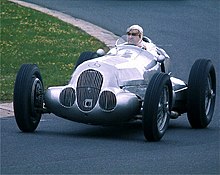
Back Silberpfeil German Flechas plateadas Spanish Silver Arrows Finnish Flèches d'Argent French Srebrne strijele Croatian Frecce d'argento Italian シルバーアロー Japanese Flechas de Prata Portuguese Silverpilarna Swedish
This article needs additional citations for verification. (March 2009) |



Silver Arrows (German: Silberpfeile) is a nickname typically given to silver racing cars with a significant connection to a German car manufacturer. Although the term was coined in 1932,[1][2] it came into popular usage regarding Germany's dominant Mercedes-Benz and Auto Union Grand Prix motor racing cars between 1934 and 1939. The name was later applied to the Mercedes-Benz Formula One and sports cars in 1954 and 1955, then to the Sauber Group C prototype racing sports cars that raced at Le Mans in the late 1980s as well as the McLaren-Mercedes Formula One cars of the late 1990s and 2000s, and is currently applied to the Mercedes-AMG Petronas F1 cars from 2010 to present.
For decades until the introduction of sponsorship liveries, each country had its traditional colour in automobile racing. German race cars for their Silver Arrows silver, Italian for their Rosso corsa red, British ones were British racing green green, French Bleu de France blue, etc.
German cars like the Blitzen Benz were white, as were the three Mercedes that won the 1914 French Grand Prix 1–2–3. On the other hand, Mercedes won the Italian Targa Florio with cars painted red in 1922 (Giulio Masetti) and 1924 (Christian Werner), blending in with the local competitors. The big supercharged 200 hp Mercedes-Benz SSKL with which Rudolf Caracciola won the 1931 Mille Miglia was called the White Elephant.
- ^ "Mercedes Classic Center". www.mbusa.com. Retrieved 7 April 2024.
- ^ "The Stripped Paint Origin Of The Silver Arrows Is A Lie". Jalopnik. 26 February 2022. Retrieved 7 April 2024.